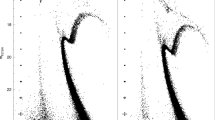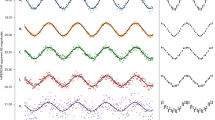Abstract
The luminosity of white dwarf stars can be attributed to the cooling process of their degenerate cores. The simple relationship existing between their luminosity and their age, together with the lack of white dwarfs fainter than log (L/L⊙)≈−4.5, provides a method of measuring the age of the disk and consequently that of the Universe1,2. Winget et al.2 have derived an age of the galactic disk of 9.3 Gyr and have then found that the Universe is young: 10.3 Gyr. These values depend on the assumption that completely ionized carbon and oxygen (the most abundant elements in white dwarf interiors) are miscible in solid phase. It is possible, however, that completely ionized carbon and oxygen separate during the process of crystallization3,4. The consequences of this behaviour on the evolution of mass-accreting carbon–oxygen white dwarfs in stellar binary systems5–7 and on the cooling process of white dwarfs8,9 have been already described. Here, we attempt to show that a galactic disk'age of 15 Gyr cannot be excluded by the white dwarf observations if carbon anil oxygen are immiscible in solid phase.
This is a preview of subscription content, access via your institution
Access options
Subscribe to this journal
Receive 51 print issues and online access
$199.00 per year
only $3.90 per issue
Buy this article
- Purchase on Springer Link
- Instant access to full article PDF
Prices may be subject to local taxes which are calculated during checkout
Similar content being viewed by others
References
Schmidt, M. Astrophys. J. 129, 243–258 (1959).
Winget, D. E. et al. Astrophys. J. 315, L77–L81 (1987).
Stevenson, D. J. J. Phys., Suppl. No. 3 41, C2/61-64 (1980).
Barrat, J. L., Baus, M. & Hansen, J. P. Phys. Rev. Lett. 56, 1063–1065 (1986).
Canal, R., Isern, J. & Labay, J. Astrophys. J. 241, L33–L36 (1980).
Isern, J., Labay, J., Hernanz, M. & Canal, R. Aslrophys. J. 273, 320–329 (1983).
Hernanz, M., Isern, J., Canal, R., Labay, J. & Mochkovitch, R. Aslrophys. J. 324, 331–344 (1988).
Mochkovitch, R. Astr. Aslrophys. 122, 212–218 (1983).
Garcia-Berro, E., Hernanz, M., Mochkovitch, R. & Isern, J. Astr. Astrophys. 193, 141–147 (1988).
Liebert, J. W. A. Rev. Astr. Astrophys. 18, 363–398 (1980).
Liebert, J. W., Dahn, C. C. & Sion, E. M. The Nearby Stars and the Stellar Luminosity Function, IAU Coll. 76 (eds Phillips, A. G. D. & Upgren, A. R.) 103–106 (Davis, Schenectady, 1983).
Mestel, L. Mon. Not. R. astr. Soc. 112, 583–597 (1952).
Iben, I. I. & Tutukov, A. V. Aslrophys. J. 282, 615–630 (1980).
Hansen, J. P., Torrie, G. M. & Vieillefosse, J. P. Phys. Rev. A16, 2153–2168 (1977).
Ichimaru, S., Iyetomi, H. & Tanaka, S. Phys. Rep. 149, 191–205 (1987).
Mayor, M. Astr. Astrophys. 32, 321–327 (1974).
Wyatt, S. P. & Cahn, J. H. Astrophys. J. 275, 225–239 (1983).
Mazzitelli, J. & D'Antonna, F. Astrophys. J. 311, 762–773 (1986).
Author information
Authors and Affiliations
Rights and permissions
About this article
Cite this article
Garcja-Berro, E., Hernanz, M., Isern, J. et al. Properties of high-density binary mixtures and the age of the Universe from white dwarf stars. Nature 333, 642–644 (1988). https://doi.org/10.1038/333642a0
Received:
Accepted:
Issue Date:
DOI: https://doi.org/10.1038/333642a0
This article is cited by
-
A white dwarf cooling age of 8 Gyr for NGC 6791 from physical separation processes
Nature (2010)
-
Evolutionary and pulsational properties of white dwarf stars
The Astronomy and Astrophysics Review (2010)
-
Past history of star formation in the solar neighbourhood from the observed white dwarf luminosity distribution
Astrophysics and Space Science (1990)
-
The luminosity function of halo white dwarfs
Astrophysics and Space Science (1990)
Comments
By submitting a comment you agree to abide by our Terms and Community Guidelines. If you find something abusive or that does not comply with our terms or guidelines please flag it as inappropriate.



